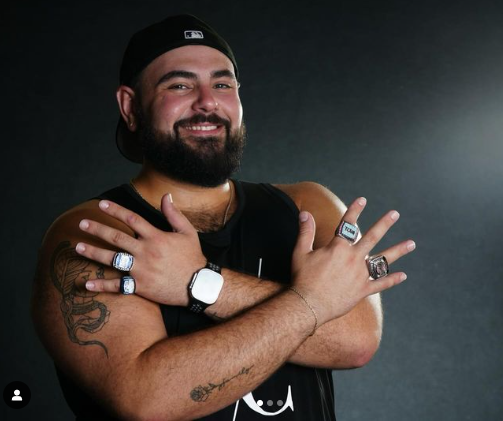Blog Layout
It’s Game Time: Competition Must Haves
September 16, 2024

It’s Game Time: Competition Must Haves
By: Alberto Rodriguez
Game day for a cheer competition is always an exhilarating experience, filled with anticipation and excitement. To ensure you’re fully prepared, there are several must-haves that can make your day smooth and successful.
First and foremost, your cheer uniform is essential. Make sure it’s clean, pressed, and fits well. Check that all accessories, such as bows, socks, and shoes, are in good condition. A well-put-together look boosts confidence and team spirit.
Next, pack a cheer bag with all necessary items. This should include water bottles to stay hydrated, healthy snacks like granola bars or fruit for quick energy, and a first-aid kit for any minor injuries. Don’t forget essentials like hair ties, bobby pins, and makeup for touch-ups.
Arrive early to familiarize yourself with the venue. Warm-up is crucial, so make sure you are stretched and ready to go. Have your routine memorized and practice any last-minute adjustments with your teammates.
Communication is key, so ensure you have a phone charger to stay connected with your coaches and teammates. Lastly, remember to bring your positive attitude and sportsmanship. Encouragement and support can make a huge difference in your performance and your team’s morale.
By preparing thoughtfully and packing the right items, you’ll be ready for game time and set for a fantastic competition day!

Alberto Rodriguez has been coaching cheer for 10 years. He danced and cheered competitively for 14 years winning many National Championships, and UDA all three years of Middle School. Bird cheered at Top Gun, Broward Elite, and Charlotte Allstars where he is going on year 4!
Bird loves the sport of cheerleading, it brings him happiness seeing his athletes feel confident, having fun doing what they love, and win!

By Lee Dominguez
•
March 4, 2025
5 Metrics That Elevate Cheer Gym Profitability When running a cheer gym, it goes beyond just coaching but also requires solid business acumen. To sustain your business, you must track the appropriate metrics. These five indicators will allow you to monitor progress, improve operations, and make sound decisions. Keeping Athletes Coming Back: Member Retention Rate – It is often less costly to retain athletes than to continually recruit new ones. Determine the number of athletes who return every season and identify the reasons leading to some of them leaving the program. Use various retention strategies like Rewarding staff with high retention rates. You can also ask parents to complete a survey and give them something in return. This is a great way to get feedback on your program. Turning Interest into Commitment: Lead-to-Member Conversion Rate – In the case where the lead to athlete inquiries ratio is above zero, how many of them actually convert? If this lately adopted method has an unsatisfactorily high conversion rate, through sales and responses, make sure that you close on new members at a higher rate. Consider streamlining the onboarding process with special trial classes, grab bag gifts, and automation of welcome messages. Maximizing Financial Stability : Revenue Per Athlete – When evaluating the pricing and value of services, this becomes especially useful. Consider whether there are any additional services that could increase revenue like merch, classes, and specialty clinics. Maximize the dollars that each member is spending. Operational Costs vs. Revenue: Maintaining a Healthy Financial Balance – Know where your money is going. If expenses are high, look for areas to streamline. Conduct regular financial audits, negotiate better vendor deals, and optimize staffing efficiency to maintain a profitable gym. Social Media Engagement Rate: Measuring Your Brand’s Impact – A strong online presence leads to more visibility and trust. Track likes, shares, and comments. A high engagement rate often correlates with strong brand loyalty and potential leads. If engagement is low, experiment with different content types and posting times. The Takeaway Numbers don’t lie. Tracking these metrics helps you make smarter, data-driven decisions for long-term success.

By Stacy Rowe
•
February 20, 2025
Time Management How many times a day or week do you say…I don’t have enough time for that? We all have the same 24 hours, 1440 minutes, and 86400 seconds in a day. So why is it that some people are able to accomplish so much more than others? YOU GUESSED IT – TIME MANAGEMENT! Okay so now we know what the difference maker is, let’s discuss some time management. This is a good time to get out some pen and paper or click on the note’s app on your phone. Let several things that you need to get done over the next few days or weeks. I’ll give you a minute. Okay, you’ve made your list. Now you are going to make everything on the list with an I for IMPORTANT or an NI for NOT IMPORTANT. What does this mean because everything is important and it all has to get done, right? Keep reading. IMPORTANT to-dos or responsibilities are ones that contribute to the achievement of your goals. NON-IMPORTANT to-dos or responsibilities are ones that DO NOT contribute to the achievement of your goals. Alright, now you want to consider your list and decide if the items on it are URGENT or NOT URGENT. You can have very important items are your list, but perhaps they are not urgent or non-important items on your list, but they are very urgent. Urgent responsibilities require immediate attention. These are often linked to the accomplishment of someone else’s goal. Ignoring urgent issues will have negative consequences. For example, you have a parent that is unhappy with their instructor and is in your office demanding a meeting right now. You must take the meeting because it is good customer service and you don’t want an unhappy customer, but this meeting is time spent not working to achieve your goals of starting a new program at your facility. It is an urgent meeting, it is necessary, but it isn’t moving the needle so to speak. After you have assessed your list you want to consider the following things – Items with important deadlines and high urgency need immediate attention; this cannot be helped. Unfortunately, these tend to be crises, pressing problems, projects that are deadline-driven, emergencies, or things that require last-minute preparations. Items with high importance but do not have urgent deadlines. These are items are usually planning, preparing, and training. The more you can add items like this to your agenda and plan far in advance, the more you are working toward your goals. The items from #1 will slow you down from #2, so you want to do everything you can to get out in front of those items and see the smoke before there’s fire, you know the old saying. Items that are both not important with high urgency are distractions. Assign these to someone else if you can. These tasks do not contribute to your goals and they take energy away from tasks that will have a positive impact on your business. Items that are not important and are not urgent basically yield no value to your objectives. They are time wasters for you and should be eliminated when possible. Here are some additional things that you can do to help you along the way in your time management journey. Question if an activity brings your closer to your goals. Consider the four statements above and categorize you to-dos. Prioritize tasks that bring you closer to your goals versus tasks that do not. Plan ahead as much and as far as possible. The more you can live in this space the less distractions you will have. Always sort your to-do list. This will help you identify what needs your attention, what can wait and what you can delegate to someone else. Good luck and happy planning!

By Stacy Rowe
•
February 4, 2025
The Pioneers of All Star My journey in cheerleading began in my early years. As a high school student, I witnessed the emergence of All Star cheerleading in our area and joined a local team before continuing to cheer in college. Through my college cheerleading coach, Abel Rosa, I connected with Premier Athletics and established my gym in 2000 in Clayton, North Carolina. Since then, I've owned and operated cheer and dance facilities with Premier Athletics. Like many veteran gym owners, I've experienced the full spectrum of the sport, I’ve pretty much seen it all. Passion runs deep in our sport, most of us OG’s do it because we love it. Admittedly, I’ve had a love, hate relationship with cheer over the years which led me to focus more on learning more about dance and helping Premier and the industry grow dance. During COVID, I stepped away from it all, needing space to breathe. I often say, "Nothing like a pandemic and a mid-life crisis to catapult you into a new direction in life." That direction, surprisingly, was writing. With my background in mathematics, including a degree and experience teaching high school math before opening my cheer and dance gym, writing seemed an unlikely path. I hadn't even developed a love for reading until my mid-twenties. Yet somehow, I decided to publish a story I'd written for my husband years earlier. During the pandemic, with extra time on my hands, I released "The Secrets We Conceal," my debut novel, on March 15, 2022. After it won several book awards, I was hooked on writing and eager to continue. I write under the name S.R. Fabrico to honor my mother who passed away when I was twenty-one years old. Her initials were S.R. Fabrico. My full name is Stacy Fabrico Rowe so when I published my first book I published as S.R. Fabrico. Challenging myself to write purely fictional work, I published "Call Her Janie" in 2023. The novel garnered numerous awards and was featured on the NASDAQ board in Times Square. What began as a single story evolved into a trilogy, with the final installment, "Janie's Hope," set to release on February 11, 2025. In recent years, serious health challenges forced me to reevaluate everything, ultimately leading me back to my roots. Through deep reflection, I realized I was meant to bridge my writing life with my All Star cheer and dance background. My business partners helped connect me with many influential figures who helped inspire and create All Star. I've spent months interviewing one hundred remarkable individuals—inspiring, complex, brilliant people who helped forge All Star's path to what it is today. Through these conversations with genuine, thoughtful, and motivational pioneers, I rediscovered my deep love for cheerleading. It's been a privilege to collect these historical accounts and weave them into a book chronicling All Star Cheer's origins. Beyond the history, the book will spotlight several pioneers who laid the foundation for our sport. Stay updated on announcements and view interview clips by following @joinmotus on Instagram, Facebook, X, and LinkedIn. Be on the lookout for the COVER REVEAL coming March 11th!

By Lee Dominguez
•
January 31, 2025
Good Habits are Your Best Friend A habit is a regular tendency that is often hard to give up. We tend to think of habits as bad like eating late at night. Habits are also good and most successful people have good habits that they do every day. Consistent small steps to create potential and greatness down the road. Start 2025 off on the right foot by creating positive habits that help you achieve your goals. This could be walking every morning before you start your day, or it could be researching the latest business trends. Maybe it’s reading one book for pleasure every week. It takes eighteen to two hundred and fifty four days for a new behavior to become a habit with the average being sixty six days. Consistency and repetition is key to forming good habits. Remind yourself when on your journey that you need to stay on track. You need to stay consistent. Create habits that you can and will stick to. For example, cutting out caffeine for a coffee drinker would be more like a lifestyle change not a new habit to form. Habits are smaller little tasks that collectively make a big difference. Choose your habits wisely. Happy habit forming😊

January 24, 2025
NEW YEARS RESOLUTIONS AND SELF CARE The day-to-day grind of being a facility owner can be overwhelming. If you’re like me, I know that you have so many ideas and different actions you want to implement, but you can’t help but feel you’re falling behind. It’s a daunting task to juggle personal life, business, and everyone else’s needs. It is so important to take the necessary time for yourself too, so that you can be the best YOU, you can be! You need to speak it and write it into existence! Below are several ideas to help you with your New Year’s Resolutions. We have also included a template for you to easily print and get started with your planning today. Personal Resolutions 1 – Attitude of Gratitude – Wake up each morning with a grateful heart. While you’re sipping your morning coffee or tea, think about three things each day that you are grateful for. This sounds simple, but often we forget to take time to smell the roses. 2 – Hobby – Choose a hobby. Select something that you enjoy doing and schedule it. That’s right, SCHEDULE that activity at least once a month. Write it in your calendar like a doctor’s appointment. It could be painting, joining a book club, or getting your nails done. Whatever floats your boat. 3 – Meditating – Meditation has tremendous benefit to your mind, body, and soul. You can easily find videos on YouTube that will walk you through the steps. If you aren’t into meditation than perhaps try prayer or just sitting silently to clear your mind. 4 – Random Acts of Kindness – You get what you give, so pay kindness forward. Take time to do something nice for someone else, just because! 5 – Aspect of Life – Choose one aspect of your life and focus on improvement. This could be eating healthier, exercising, paying off debt, or saving more money. Whatever it is, make a plan and stick to it. Business Resolutions 1 – Speak Your Vision – Spend some time with your key personnel and determine what your vision is. Where are you headed? What do you hope to accomplish years down the road? Create this vision then share it with your staff. Figure out how to implement it into your every day at work. 2 – Training – Decide what kind of training you need or want to offer to your staff. Set dates, today. Then set benchmarks for yourself to plan and prepare for the trainings. It’s easy for iClassPro customers to stay in the know about software updates and offerings with FREE live interactive webinars held throughout the year. Stay informed about upcoming webinars by signing up for our eNewsletter and/or following us on Facebook. 3 – Evaluate Your Business – Look back at your previous year’s financials. Where did you do well? Where can you do better? Choose one area of improvement, create a plan, and implement it. 4 – Class Management – Dive into your content management system (CMS) and set a goal to learn something new. If you are an iClassPro costumer, you may not be using all of our great features. Set a goal to maximize your CMS potential. 5 – Plan A Party – Do something fun with your staff. A simple gathering where everyone brings a dish would be great. It’s important to take a moment to celebrate your accomplishments and just enjoy each other’s company.

By Lee Dominguez
•
January 8, 2025
What's Your Why? By: Lee Laurence It's easy to become engrossed in the daily grind as a coach or club owner. Every great coach or company, however, has a "why" that propels them on in difficult circumstances. Then, what is your reason? 1. Pick Your Interest It takes effort to coach or run a gym. Sometimes it feels like there is too much pressure to achieve and work long hours. However, you have a steady supply of inspiration to keep you going when you know your why, whether it's assisting athletes in realizing their potential, creating a community of support, or just sharing your passion for cheerleading. 2. Sync Your Behavior with Your Motivation Knowing your why is one thing, but living it out every day is quite another. Ensure that your priorities, choices, and everyday activities are in line with your mission. Make sure you're creating an environment that promotes growth if your aim is to assist athletes in developing. If fostering a sense of community is your goal, concentrate on developing deep relationships both within and beyond the gym. 3. Motivate People with Your Why Your why can serve as a strong motivation for your athletes, employees, and even the people who frequent your gym. People are more inclined to support your vision and stick with your gym when they see your passion and understand your objective. 4. Remain grounded when faced with obstacles. When you are dealing with difficulties, it is easy to lose sight of your why. But you can persevere through difficult times by remaining committed to your goal. Whether it's a challenging time of year, unforeseen costs, or a worldwide pandemic, knowing your why can help you stay rooted and you the fortitude to keep going. 5. Review Your Motivation Often Your motivation may change as your gym expands. That is quite normal. To make sure it still speaks to you and is in line with the path your gym is taking, however, be sure to periodically review your why. Your motivation may fluctuate as your gym's demands do, and that's alright. Just be sure that your why stays true to who you are and real. In summary: The cornerstone of long-term success as a coach or gym owner is understanding your why. It helps you overcome obstacles and motivate others by giving you a feeling of purpose and direction. Make sure your motivation is obvious and use it to direct your choices and activities. In addition to propelling your success, your passion will fortify the ties that bind your gym community together.

December 17, 2024
"I found this to be an interesting read, with many great points and clarifications. Jeff's vision has been a benefit to all cheerleaders across the globe. I recommend giving this a read." ~Cole Stott Letter from Jeff Webb
Founder, Varsity Spirit
President, International Cheer Union I have been asked to address the October 22 article on cheerleading in The New York Times Magazine. As a backdrop, let me begin by saying that the reporter viewed cheerleading and its development through a negative lens. While I agree there is always more that can be done to move our sport forward in a positive way, the article frankly misrepresented some important facts about how modern cheerleading developed and why. So let me provide my own historical perspective. What began 50 years ago as a simple idea to change a traditional school activity has become a global reality. Millions of young people around the world participate in cheerleading, and our governing body, the International Cheer Union, is now even recognized by the International Olympic Committee. The industry we built includes thousands of dedicated professional coaches, gym owners, judges and choreographers, alongside millions of athletes. While challenges remain, the collective impact of our work is undeniable. When I founded UCA (Varsity’s predecessor organization) in 1974, my young team and I were pioneering the use of stunts and pyramids to modernize cheerleading and to increase its athleticism and entertainment value. We developed climbing, bracing, and transitional techniques that allow teams to perform the exciting routines seen in Cheer today around the world. As we experimented with new approaches and transitions, some proved unsafe for many teams to execute consistently, so we banned them. Examples include mini-tramp, three-high pyramids and double back flips in basket tosses. We were pioneering a new sport, and specific safety standards evolved as the sport evolved. This is how almost all sports develop (for example, batting helmets weren’t originally used in baseball, and football has rules that now specifically protect a vulnerable quarterback). Again, while not every new idea we tried worked, safety was always at the forefront of our decisions. Originally there was only school cheerleading. All-Star did not really take off until the mid 1990s. As a private company, Varsity lacked the authority to require schools to follow our safety rules, so we created a nonprofit organization (AACCA) and hired the nation’s leading sports safety expert to develop the first comprehensive manual and program to guide cheerleading nationwide. The nonprofit was established to ensure there was no "profit motive" influencing the rules. In fact, Varsity contributed significantly to develop this program, which had a profound impact on cheerleading safety across the U.S. It was adopted by many state athletic associations and became the basis for the National High School Federation’s safety program. The NCAA also adopted its principles. The article included a quote from Dennis Worley referring to “the wild west.” Dennis was specifically describing the early days of All-Star cheerleading, not the broader cheerleading landscape as the reporter implied. In the early days of All-Star, there were no universally accepted rules, and individual event companies often had their own. This lack of standardization led to an increase in injuries, as reported in emergency room surveys. However, the injuries were categorized under “cheerleading” as a whole without distinguishing between school and All-Star segments. To address this, Varsity and two other companies established the US All Star Federation (USASF) to enhance safety in the new All-Star segment of cheerleading. USASF developed safety rules, invited other competitors to participate as members, and introduced events like “Worlds” to incentivize compliance. This initiative took years, substantial effort, and millions of dollars in investment from Varsity to bring structure and safety to All-Star cheerleading. Today, USASF operates independently, thanks in large part to the resources provided by this effort. Keep in mind that some have questioned the reliability of the primary survey the reporter relied on to portray cheerleading as inherently dangerous. In fact, in 2023 the Consumer Products Safety Commission showed fewer emergency room visits for cheerleading than soccer, volleyball, softball and girls’ basketball. Nevertheless, the work of ensuring our athletes are as safe as possible must continue to evolve as Cheer evolves. This includes constant evaluation of where injuries occur, establishing their cause, and then taking whatever steps are necessary to improve safety. As we go forward, it is important that everyone involved in our sport focus on this as our top priority. Regarding competition and Varsity’s portrayal as overly aggressive – frankly, business is inherently competitive. I don’t know of instances where Varsity intentionally targeted other events, but I do understand the company’s desire for strategic expansion. Successful companies play to win, and that’s part of building something that lasts. That said, I’ve always believed the industry is strongest when customers have a variety of options. Ultimately, customers decide where to go based on perceived value—quality, service, and cost—and they vote with their feet and wallets. The article also attempted to paint a negative picture of my relationship with Lawrence Herkimer, founder of NCA. When I resigned from NCA in 1974, it was because I felt the organization wasn’t prepared to embrace the changes I believed were vital for cheerleading’s future. I left on good terms and, at Herkie’s request, even stayed through the summer to run many of NCA’s largest camps. When I started my own organization, I reached out to 20 instructor friends to see if they wanted to embark on this new adventure with me. These individuals, none of whom were under contract to NCA, took a chance on a fledgling start-up with no guarantee of success. I have always been grateful for their courage and commitment. There was also a comment in the article about a rumor that I had sent a wreath and an “I will bury you” note to Herkie after I resigned. This is a complete fabrication. I wished Herkie and NCA no ill will. I simply wanted to pursue my vision for cheerleading. Even as competitors, Herkie and I maintained a cordial relationship over the years. And when Varsity and NCA merged in 2004, he was extremely supportive of the new combined entity and worked closely with me to ensure a smooth transition to “one company.” The reporter’s characterization of my comments comparing cheerleading to chess and billiards was also misleading. It was during a 2012 court case on Title IX compliance and contrasting the athleticism of U.S. cheerleading to the international definition of sport, which includes less athletic endeavors such as chess and billiards. The reporter flatly misrepresented my position. Regarding abuse allegations in our industry, it’s true that no sport or youth activity is immune to isolated incidents involving bad actors. I firmly believe such behavior must be addressed swiftly and decisively. And while even one is too many, I believe that these instances are the exception, not the rule. The vast majority of individuals in cheerleading at all levels are dedicated to fostering a positive and safe environment for athletes. On the topic of expense, like many youth sports, cheerleading offers a range of participation levels. School and recreational cheerleading are relatively affordable, while high-level competitive All-Star cheerleading can be more costly due to competition fees, travel, custom uniforms, gym fees, and other factors. The decision of where and how to participate is made solely by the parents and the athletes, and I think it is healthy that a wide array of choices exists. I do wish cheerleading at all levels could be accessible to every family. We must work collectively to explore ways to reduce financial barriers. In conclusion, have things been perfect over the past 50 years of modern cheerleading? Of course not. But from its inception, our efforts were about building something new and extraordinary—not about profit. We made mistakes, learned, and grew, with the singular goal of creating an athletic, entertaining, and fun sport. To critics who prefer to view our sport through a negative lens, I encourage you to see the bigger picture. As millions of young athletes will attest, cheerleading fosters teamwork, builds character, and enriches the lives of its participants. I remain as committed as I was 50 years ago to this incredible sport and to the athletes, parents, and professionals who make it what it is today. To my colleagues, coaches, gym owners, and athletes—thank you for helping to make this dream a reality. Here’s to the future of cheerleading and all we can accomplish together.

By Stacy Rowe
•
November 8, 2024
Tips for New Coaches By: Lee Laurence It can be daunting to take on a coaching role for the first time. Making the switch to coaching has its own set of difficulties, regardless of whether you have experience cheering or are simply passionate about working with athletes. Here are some tips for navigating the initial phases of your coaching career and laying solid groundwork for success. 1. Put Communication First Effective communication is essential for coaches. It takes more than just teaching your athletes; it also involves getting to know them, learning about their objectives, and being able to provide constructive criticism in a way that inspires them to get better. Make sure that expectations, practice schedules, and any other pertinent information are communicated to your athletes' parents at all times. MotUS Tip: Don't be scared to communicate excessively in the beginning. Developing that trust early on facilitates future transactions. 2. Establish Boundaries It's natural to want to be friends with your athletes, particularly if you're similar in age or have recently left the sports world. But establishing boundaries early on will help you keep control and make sure your players respect you as a coach. Be firm but kind. Being the tough one has its advantages, but ultimately, you're there to support their growth. Early coaching style establishment and a willingness to hold athletes accountable are two MotUS tips. In the long run, they will respect you for it. 3. Make athlete development a top priority. As a coach, your main objective should be to help your athletes grow on all levels—physically, psychologically, and emotionally. Encourage children to make objectives for themselves and monitor their development over time. Honor little accomplishments and assist them in realizing their own development. Season after season, they will remain inspired and return if development is prioritized. MotUS Tip: Make sure to check in with your athletes individually. This strengthens the relationship between coach and athlete and demonstrates your interest in their personal development. 4. Continue to Learn Even the most seasoned coaches are aware that they can always get better. Remain receptive to the opinions of athletes, gym owners, and other coaches. You can also improve your abilities and keep up with the most recent developments in cheerleading training by enrolling in online courses or attending coaching clinics. MotUS Tip: Participate in a coaching community where you may give advice, learn from each other's experiences, and share ideas. 5. Remain upbeat It can be stressful to coach, and if things don't work out as planned, it's easy to lose hope. But keep in mind that your enthusiasm is infectious. Your athletes will remain focused and upbeat if you do. Maintain a growth mentality and recognize that every obstacle presents a chance for you and your team to improve. MotUS Tip: Turn failures into teaching opportunities for your players and yourself. Every challenge is an opportunity to get stronger. In summary: The path to becoming a coach is both rewarding and difficult. You'll position yourself for success by emphasizing athlete development, establishing limits, and concentrating on good communication. Continue to study, maintain your optimism, and never forget that every action you take as a coach will not only aid in your athletes' development but also mold you into the leader they require.

October 24, 2024
Branding Your Cheer Gym: Build a Legacy That Lasts By: Lee Laurence Running a cheerleading gym goes beyond teaching skills and preparing for competitions—it's about creating a lasting experience for your athletes, their families, and the community around you. That’s where branding plays a big role. Branding isn’t just a logo or a catchy name. It’s the impression you leave on everyone who interacts with your gym. It’s what makes your gym stand out, even in an industry as energetic and competitive as cheerleading. In cheer, where athletes and parents invest their time and trust, your brand builds loyalty and creates a sense of belonging. Why Branding Is Key for Your Cheer Gym When you think of the top cheerleading gyms, what comes to mind? Maybe it’s their competition success, but often it’s how they make their athletes feel. That’s the real power of branding. For cheer gyms, branding helps you: Attract the right athletes and families: A clear brand message helps you communicate what your gym stands for. Whether your focus is on high-level competition or building a positive, inclusive environment, your brand sets the tone before anyone even walks through your doors. Build trust and loyalty: Parents and athletes want to feel like they’re part of something special. A strong brand with a clear mission makes them proud to belong to your gym, turning members into loyal advocates. Stand out from the competition: With so many cheer gyms around, what makes yours different? Branding is what turns your gym from just another option into the gym that people choose for their athlete’s journey. Building a Brand That Reflects Your Gym's Values. Branding isn’t just about colors, fonts, and logos (though those are important). It’s about defining who you are and what sets you apart. Here’s how you can build a brand that truly speaks to your cheer community: Know Your Story: Every gym has its own unique story. Maybe you started your gym to create a positive, family-like environment for athletes. Or maybe you’re focused on pushing athletes to their competitive best. Whatever your story is, make it the heart of your brand. Define Your Values: Are you all about personal development and teamwork? Or is your focus on training elite athletes? Get clear on your gym’s core values and make sure your brand reflects them. These values should be evident in everything you do, from your website to how you engage with families. Create a Visual Identity: Your gym’s visual branding—like logos, colors, an uniforms—should tell a story. Is your gym bold and competitive, or more welcoming and nurturing? Choose design elements that reflect your gym’s vibe and energy, and ensure that your branding stays consistent across every platform and interaction. Be Consistent in Experience: Your brand is more than just visuals—it’s how you interact with your athletes and families every day. From your welcome emails to social media posts and face-to-face conversations, every touchpoint should reflect your brand’s values and personality. Whether you're promoting a positive, supportive gym culture or a competitive edge, make sure your audience feels it in every interaction. Branding Is for All Gyms, Big or Small No matter the size of your gym, branding is key. You don’t need to have national titles under your belt to build a strong brand. What matters most is staying true to your story and being consistent. Your authenticity is what will make your gym stand out and attract the right people. How MotUS Can Help You Strengthen Your Brand At MotUS, we understand that building a brand can feel overwhelming. But the good news is—you’re not in this alone. We’ve built a community of gym owners who share ideas and collaborate to create meaningful, impactful brands. Through the MotUS Vault, you have access to resources that can guide you in developing your gym’s brand, from designing logos to crafting your story. We also offer one-on one consulting to help refine your strategy, ensuring your brand resonates with your target audience. Whether you’re just starting your gym or looking to refresh your brand, we’re here to help you create something that lasts. In summary, branding is essential for creating a cheerleading gym that not only attracts athletes but also builds a lasting legacy. By focusing on your gym’s values, story, and the overall experience you provide, you can build a brand that becomes a symbol of pride and dedication. With the right support from MotUS, you’ll be on your way to building a brand that stands out and stands strong.


